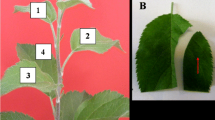Abstract
French bean (Phaseolus vulgaris) leaves were inoculated with three pathogenic and two nonpathogenic isolates ofBotrytis cinerea and the infected tissues, containing either spreading lesions or lesions limited in size, were investigated for the presence of phytoalexins. In most cases phaseollin, phaseollidin, phaseollinisoflavan, the phaseollin metabolite, 6a-hydroxyphaseollin, and a few unidentified antifungal compounds were found; phaseollin was predominant. The concentration of phaseollin accumulating in leaves infected by the nonpathogenic isolate BC-5 was about twice as high as that in infections produced by pathogenic isolates. In contrast, leaves infected by the nonpathogenic isolate BC-6 only contained low concentrations of phaseollin.
Our data do not provide strong evidence that phaseollin is the principal factor that limits lesion development.
Samenvatting
Bladeren van boon (Phaseolus vulgaris) werden geïnoculeerd met drie pathogene en twee niet-pathogene isolaten vanBotrytis cinerea, als gevolg waarvan zich uitbreidende lesies, resp lesies van beperkte omvang ontstonden. Deze lesies werden samen met een omringend groen gedeelte onderzocht op de aanwezigheid van fytoalexinen. Hiertoe werden deze stoffen geëxtraheerd uit drooggevroren bladmateriaal, en gezuiverd m.b.v. kolomchromatografie over Sephadex LH-20 (Tabel 1) en dunnelaag-chromatografie (Tabel 2). Kwantitatieve analyse vond plaats d.m.v. in situdensitometrie.
In de meeste gevallen werden phaseolline, phaseollidine, phaseollineïsoflavaan, een omzettingsprodukt van phaseolline, nl. 6a-hydroxyphaseolline, en enkele onbekende fungitoxische stoffen aangetoond (Fig. 1). Phaseolline was het meest voorkomende fytoalexine (Fig. 2 en 3). De concentratie van phaseolline in bladeren geinfecteerd met het niet-pathogene isolaat BC-5 was ongeveer tweemaal zo hoog als in bladeren geïnfecteerd met een pathogeen isolaat (isolaat BC-1, BC-3 en BC-4). Daarentegen bevatten bladeren die met het niet-pathogene isolaat BC-6 waren geinfecteerd slechts lage concentraties phaseolline.
De hoeveelheden phaseolline en 6a-hydroxyphaseolline, omgerekend per lesie, namen snel toe in zich uitbreidende lesies van isolaat BC-1, terwijl de toenamesnelheid van deze stoffen afnam in lesies van isolaat BC-5, die beperkt van omvang bleven (Fig. 4).
De resultaten geven geen duidelijke aanwijzingen dat phaseolline de belangrijkste remmende factor zou zijn bij het beperkt blijven van lesies.
Similar content being viewed by others
References
Bailey, J. A., 1974. The relationship between symptom expression and phytoalexin concentration in hypocotyls ofPhaseolus vulgaris infected withColletotrichum lindemuthianum. Physiol. Pl. Path. 4: 477–488.
Bailey, J. A. & Ingham, J. L., 1971. Phaseollin accumulation in bean (Phaseolus vulgaris) in response to infection by tobacco necrosis virus and the rustUromyces appendiculatus. Physiol. Pl. Path. 1: 451–456.
Biggs, D. R., 1975. Post-infectional compounds from the French beanPhaseolus vulgaris; isolation and identification of genistein and 2′, 4′, 5, 7-tetrahydroxyisoflavone. Aust. J. Chem. 28: 1389–1392.
Elliston, J., Kuć, J., Williams, E. B. & Rahe, J. E., 1977. Relationship of phytoalexin accumulation to local and systemic protection of bean against anthracnose. Phytopath. Z. 88: 114–130.
Heuvel, J. van den, 1976. Sensitivity to, and metabolism of, phaseollin in relation to the pathogenicity of different isolates ofBotrytis cinerea to bean (Phaseolus vulgaris). Neth. J. Pl. Path. 82: 153–160.
Heuvel, J. van den & Glazener, Judy A., 1975. Comparative abilities of fungi pathogenic and nonpathogenic to bean (Phaseolus vulgaris) to metabolize phaseollin. Neth. J. Pl. Path. 81: 125–137.
Jerome, S. M. R. & Müller, K. O., 1958. Studies on phytoalexins. II. Influence of temperature on resistance ofPhaseolus vulgaris towardsSclerotinia fructicola with reference to phytoalexin output. Aust. J. biol. Sci. 11: 301–314.
Keen, N. T., Zaki, A. I. & Sims, J. J., 1972. Biosynthesis of hydroxyphaseollin and related isoflavanoids in disease-resistant soybean hypocotyls. Phytochemistry 11: 1031–1039.
Rahe, J. E., 1973. Occurrence and levels of the phytoalexin phaseollin in relation to delimitation at sites of infection ofPhaseolus vulgaris byColletotrichum lindemuthianum. Can. J. Bot. 51: 2423–2430.
Smith, D. A., VanEtten, H. D. & Bateman, D. F., 1975. Accumulation of phytoalexins inPhaseolus vulgaris hypocotyls following infection byRhizoctonia solani. Physiol. Pl. Path. 5: 51–64.
VanEtten, H. D. & Pueppke, S. G., 1976. Isoflavonoid phytoalexins. In: J. Friend & D. R. Threlfall (Eds.), Biochemical aspects of plant-parasite relationships. Academic Press, London: 239–289.
Author information
Authors and Affiliations
Rights and permissions
About this article
Cite this article
Van Den Heuvel, J., Grootveld, D. Phytoalexin production in French bean leaves infected by botrytis cinerea. Netherlands Journal of Plant Pathology 84, 37–46 (1978). https://doi.org/10.1007/BF01976407
Accepted:
Issue Date:
DOI: https://doi.org/10.1007/BF01976407




